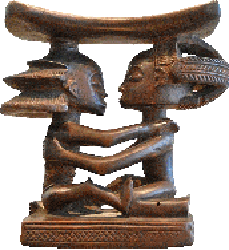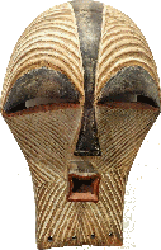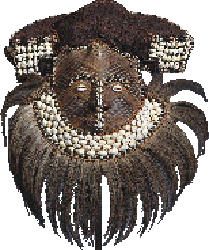°Arcus°
Home » Creation stories » Central Africa
CREATION STORIES FROM CENTRAL AFRICA

BALUBA
In the beginning, Kabezya-Mpungu created the world and the earliest human beings. These humans did not yet possess a heart. Kabezya-Mpungu ordered the cosmos, achieving a balance between sun, moon, rain and darkness, and then departs from the scene, becoming invisible and unattainable to the humans he had made.
As a final act in the creation of life, the departing Kabezya-Mpungu sends Mutshima ("heart"), which dwells within humans and represents the life-giving part of the species, that which reflects the world of the divine.
Another story tells of a rivalry between two creator figures. The major creator was known as Fidi Mkullu, who was challenged by the trickster Kadifukke, who claimed that he had been born of the earth, rather than created by his opponent. Fidi Mkullu was so irate at this that he called upon his son to fight Kadifukke.
This did not go well for Fidi Mkullu's offspring, who was almost killed. Hence, Fidi Mkullu imprisoned Kadifukke in a hut, which he proceeded to set ablaze. Kadifukke, however, made good his escape. Eventually, Fidi Mkullu was forced to treat with Kadifukke, stating that he was white, while the trickster was black.

BASONGE
In the beginning, Fidi Mkullu created the earth. His son, Mwile, however, was unimpressed and began boasting that he was the creator of the universe. For his arrogance, he was renamed Nkolle. Fidi Mkullu challenged Nkolle to go down to earth to rule the human population in a creative manner. Thus, Nkolle became a great ruler on earth, though his efforts to alleviate pain, sickness and death proved singularly unsuccessful.
As a result, Nkolle departed and the people pleaded with Fidi Mkullu to become their chief. He did so and helped to assuage much - but not all - of the things which troubled the people, thus proving that he - and not Nkolle - was the true creator.
Some of the Basonge, however, regarded Nkolle as the creator: under his original name of Mwile, he made the earth, only to be challenged by a trickster figure known as Kolombo mui fangi, who claimed that he created himself without any action on the part of Mwile. This led Mwile to spit out a piece of clay to create a human, who he placed on the earth. Kolombo, however, managed to emulate this action. The pair next challenged one another to make their creation speak. Mwile succeeded, but Kolombo failed: his human could move its lips, but no sound could it make.
Next, Mwile caused his human to die, challenging Kolombo to do the same. Kolombo destroyed his man. Mwile then delivers a coup de grâce by trapping Kolombo and his allies in a hut, which he set on fire. Kolombo, however, managed to escape, by having his people tunnel to his village, while he told a bird to lay eggs on the floor. These eggs exploded in the flames, which led Mwile to presume that his foe had met his end. However, much to his chagrin, he found no corpse, only scorched shells.
BOSHONGO
In the beginning, Bumba existed within an expanse of darkness and water. One day, he felt a severe pain in his stomach, which was alleviated when he brought forth the sun by means of vomiting. The sun shone on the water and caused it to dry up, leading to the emergence of dry land. Next, Bumba had several further vomiting fits which produced the moon and stars, then a number of animals which took his name: -
- Koy Bumba, the leopard;
- Ganda Bumba, the crocodile; and
- Kono Bumba, the tortoise.
Last of all, Bumba created men. One of these, Loko Yima, was white like Bumba. Meanwhile, the animals Bumba had vomited proceeded to fashion other creatures after their kinds. Of the children of Bumba, only Tsetse - lightning - caused issues and had to be confined to the sky. She still strikes her old home in wrath to this day.
BULU
In the beginning, there was Membe'e, a being whose role is the supporting of the world. He had a son, Zambe, who was dispatched to create Man, Elephant, Chimpanzee and Gorilla, naming each of them after himself. The men he created were two in number, one black and one white. Zambe gave his creatures the tools to support themselves, water, fire and the written word, the latter in the form of a book.
However, new forms of life arose in the fire. From this, smoke entered the eyes of the white man, whereupon he departed with the book. Chimpanzee left for the forests, forsaking civilisation to live on fruit. Gorilla soon made the same decision and followed Chimpanzee. Elephant, meanwhile, stood around musing on nothing in particular. The black man alone remained at the fire side, continuing to stoke it. He was, however, unconcerned about the book.
Eventually, Zambe returned to the earth to see his creation. He asked what they had done with his creations. Chimpanzee and Gorilla told their story, whereupon Zambe condemned them to have hairy bodies and large teeth, decreeing that they remain for eternity within their forest. Elephant was dealt with in a similar way. Zambe then approached the black man, asking him where the book was. The black man said that he was too busy tending the fire to read it. Zambe's response was to inform him that, due to his lack of book knowledge, the black man would have to spend his time working on others' behalf. Lastly, Zambe visited the white man, decreeing that, as he was so keen on reading books, he would come to gain much knowledge from them, but would need the black man to care for him, as he had few practical skills.
Thus, animals live in the forests, white men spend their days reading and idling, while black men work hard but always maintain a good fire.
EFÉ
The first man - Baatsi - was created by the Supreme Being with the assistance of the moon. He was formed from clay, which the Supreme Being covered with skin and filled with blood. The Supreme Being also created the first woman and he told the man to procreate with her, with only one divine injunction: they were not to eat from the Tahu Tree.
Some time later, the people had multiplied. Baatsi had become the father and grandfather of many people, all of whom obeyed the Supreme Being. When they grew old, they were spirited up to Heaven.
However, one day a pregnant woman developed a craving for the forbidden fruit of the Tahu Tree. She managed to convince her husband to collect some for her. This was witnessed by the moon, who reported it to the Supreme Being. As a result of the actions of the woman and her husband, death came into being. Now, instead of being translated into Heaven, humans are condemned to die and be buried beneath the earth.
FANG (FÃN, PAHOUIN)

In the beginning, there was Nzame or Nzambe, a triune deity formed of Nzame, Mebere and Nkwa. The first part created the heavens and the earth and breathed life into it, whereupon he called Mebere and Nkwa to ask if they felt it needed something else. Mebere and Nkwa suggested that Nzame form a chief for the earth. He made the elephant, leopard and monkey to serve as triumvirs, but this failed to satisfy him.
Next, the three parts of the godhead made a new creature, Fam ("Power"), with aspects from all three: -
- strength from Nzame;
- leadership from Mebere; and
- beauty from Nkwa.
Fam was thus placed in charge of the earth, while the godhead returned to the heavens.
For some time thereafter, all seemed well enough on earth. The elephant, leopard and monkey obeyed Fam, but Fam soon became overbearing and exhibited his cruelty by his actions towards the animal - including the three former leaders. Eventually, he ceased to worship Nzame, claiming his own priority over the earth.
Enraged by this impertinence, Nzame sent thunder and lightning, which destroyed the world bar Fam, who had been promised eternal life. Thus, Fam remains at large, causing trouble. Thereafter, the earth remained barren for a while, which prompted the godhead to set a new creation in motion. They set soil upon the surface and covered it with forests, using seeds dropped from a tree which grew in the soil they had placed. Additionally, the leaves from this tree became fish and land animals, eventually developing into the world we see today.
Thus, our earth is built upon the ruins of a former earth, whose existence is evidenced by the presence of combustible coal beneath the surface.
Humans came into existence in one of two ways. Some stories tell of Mebere fashioning a lizard from clay, which he placed in the sea for eight days. From this emerged the first human being. Otherwise, the godhead decide to create a new Fam, better disposed towards them, and one who would eventually taste grim death. To this end, a man - Sekume - was created. Sekume was joined by the first woman, Mbongwe, who was created from a tree. Sekume is the earliest ancestor of humankind. The couple were made with both a body and a soul: the latter gives life to the body and is the shadow of the body, and is immortal. The soul has a star-like spot in the centre of its eye. Sekume and Mbongwe proceeded to multiply, remaining wary of the nefarious activities of Fam, who was wont to attempt to dig his way out of the underground place where he had been imprisoned by Nzame.

KUBA
In the beginning, Mbombo, described as a gigantic white entity, fashioned the cosmos ex nihilo. He found himself alone within the darkness of the primordial world, and saw that the oceans covered the earth. Some time later, Mbombo began to feel a tremendous pain within himself, which was alleviated after he brought forth the sun, moon and stars from his mouth. The sun began to heat the earth, evaporating the water and creating clouds. Some time thereafter, hills of dry land emerged from the primal waters.
Mbombo vomited for a second time, bringing forth nine animals: -
- Koy Bumba, the leopard;
- Ponga Bumba, the eagle;
- Ganda Bumba, the crocodile;
- Yo Bumba, the fish;
- Kono Bumba, the tortoise;
- Tsetse Bumba, a black leopard-like big cat;
- Nyanyi Bumba, a heron;
- a scarab; and
- Budi, a goat.
These nine figures were then tasked to continue the work of creation. This they did. Ganda Bumba created all reptiles, while Nyanyi Bumba brought all birds (with the exception of the kite) into being. Yo Bumba populated the waters with fish, and Budi made all horned creatures. The scarab created the little insects.
At the end of this process, three of Mbombo's offspring in turn attempted to complete creation. The first of these was Nyonye Ngana, who vomited white ants before dying. His creation went deep into the earth to find soil in order to bury him, which enriched the previously-sandy surface of the planet.
The next to try was Chonganda, who formed the first plant, which in turn brought all plants into being. The third attempt was made by Chedi Bumba, who made the kite.
Meanwhile, Tsetse Bumba was causing trouble on earth, which prompted Mbombo to chase her into the sky, where she became the thunderbolt. This, however, left the early human populations bereft of fire, which prompted Mbombo to teach them how to bring it forth using trees.
Once everything was as he wished it to be, Mbombo left the earth for the heavens, leaving the former in the hands of humanity. His final loving act to his creation was to leave Loko Yima to serve as his regent. In the meantime, Nchienge, the woman of the waters, who dwelt to the east of the world, had a son, Woto. In time, Woto emerged as the first king of the Kuba peoples.
NGOMBE (BANGALA)
In the beginning, there was Akongo. He dwelt in the heavens, with the people on earth. However, the discord among the earth dwellers was such that Akongo grew weary and departed from the scene and has never been heard of since.
Other stories place the blame for this upon Mbokomu, a woman who lived in the sky world. Akongo - and her fellow sky dwellers - found her so annoying that he dropped her onto earth in a basket, along with her children.
Initially, they did well, but Mbokomu had a nagging fear that her family would die out. She convinced her son to marry her daughter. He did so with reservations, and the girl became pregnant.
One day, as she walked around, she met a hairy creature who introduced himself as Ebenga. She gave him a shave, which caused him to look almost human. He was, however, of an evil disposition, and he cursed the woman and her unborn offspring.
The child was born, but grew up to be a witch. Ebenga also plagued the brother-sister couple's other children and all of their descendants.
